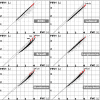A mathematical reason for FEV1/FVC dependence on age
- PMID: 22762777
- PMCID: PMC3461438
- DOI: 10.1186/1465-9921-13-57
A mathematical reason for FEV1/FVC dependence on age
Abstract
Background: Recent studies have showed that FEV1/FVC describing correspondence between the forced expiratory volume in one second (FEV1) and forced vital capacity (FVC) depends significantly on age. However, the nature of this dependence is uncertain. The study aim is to analyze mathematically the relationship between FEV1 and FVC to find a cause of the FEV1/FVC dependence on age in healthy subjects.
Methods: The relationship was examined for 1,120 males and 1,625 females--Polish (Caucasian) population, healthy, never-smoking, aged 18 - 85 years, who performed a technically adequate spirometry maneuver. Lung functions were measured using the LungTest1000 (MES, Poland) with maximal effort according to the ATS/ERS guidelines.
Results: A very strong, age-independent linear relationship between FEV1 and FVC was found in healthy individuals (the correlation coefficient r = 0.96). It can be described with the equation FEV1 = A x FVC + C, where A = 0.84 and C = -0.23 (-0.36) for females (males). As C is different from zero, FEV1/FVC depends on FVC because FEV1/FVC = A + C/FVC, in average. And thus, since FVC is significantly age-dependent, FEV1/FVC has to be also age-dependent because of the term C/FVC. In particular, the smaller the FVC value because of advanced age, the more significant the fall of FEV1/FVC.
Conclusions: FEV1/FVC dependence on age in healthy individuals is of mathematical rather than biological nature. Due to the strong correlation between FEV1 and FVC in healthy subjects, the difference between patient's FEV1 and the FEV1 value expected for patient's FVC seems to be a more natural, age-independent description of the correspondence between patient's FEV1 and FVC.
Figures




Similar articles
-
Combined Forced Expiratory Volume in 1 Second and Forced Vital Capacity Bronchodilator Response, Exacerbations, and Mortality in Chronic Obstructive Pulmonary Disease.Ann Am Thorac Soc. 2019 Jul;16(7):826-835. doi: 10.1513/AnnalsATS.201809-601OC. Ann Am Thorac Soc. 2019. PMID: 30908927 Free PMC article.
-
A Simple Measure to Assess Hyperinflation and Air Trapping: 1-Forced Expiratory Volume in Three Second / Forced Vital Capacity.Balkan Med J. 2017 Apr 5;34(2):113-118. doi: 10.4274/balkanmedj.2015.0857. Balkan Med J. 2017. PMID: 28418337 Free PMC article.
-
People with older age and lower FEV1%pred tend to have a smaller FVC than VC in pre-bronchodilator spirometry.Respir Physiol Neurobiol. 2014 Apr 1;194:1-5. doi: 10.1016/j.resp.2014.01.003. Epub 2014 Jan 18. Respir Physiol Neurobiol. 2014. PMID: 24448311
-
Lower limit of normal or FEV1/FVC < 0.70 in diagnosing COPD: an evidence-based review.Respir Med. 2011 Jun;105(6):907-15. doi: 10.1016/j.rmed.2011.01.008. Epub 2011 Feb 5. Respir Med. 2011. PMID: 21295958 Review.
-
Spirometric standards for healthy male lifetime nonsmokers.Hum Biol. 1989 Jun;61(3):327-42. Hum Biol. 1989. PMID: 2680887 Review.
Cited by
-
Rapid FEV1 decline and the effects of both FEV1 and FVC on cardiovascular disease: A UK biobank cohort analysis.BMC Public Health. 2024 Nov 19;24(1):3214. doi: 10.1186/s12889-024-20716-1. BMC Public Health. 2024. PMID: 39563289 Free PMC article.
-
Novel equations better predict lung age: a retrospective analysis using two cohorts of participants with medical check-up examinations in Japan.NPJ Prim Care Respir Med. 2015 Mar 19;25:15011. doi: 10.1038/npjpcrm.2015.11. NPJ Prim Care Respir Med. 2015. PMID: 25789796 Free PMC article.
-
The association between forced expiratory volume in one second (FEV1) and pulse oximetric measurements of arterial oxygen saturation (SpO2) in the patients with COPD: A preliminary study.J Res Med Sci. 2014 Mar;19(3):257-61. J Res Med Sci. 2014. PMID: 24949035 Free PMC article.
-
Physiological Network From Anthropometric and Blood Test Biomarkers.Front Physiol. 2021 Jan 12;11:612598. doi: 10.3389/fphys.2020.612598. eCollection 2020. Front Physiol. 2021. PMID: 33510648 Free PMC article.
-
Effect of different conditioning methods of traditional Chinese health exercise on lung function in healthy middle-aged and elderly people: study protocol for a randomized controlled trial.Trials. 2022 Jan 3;23(1):8. doi: 10.1186/s13063-021-05980-5. Trials. 2022. PMID: 34980233 Free PMC article.
References
-
- Mead J, Turner JM, Macklem PT, Little JB. Significance of the relationship between lung recoil and maximum expiratory flow. J Appl Physiol. 1967;22:95–108. - PubMed
-
- Pride NB, Permutt S, Riley RL, Bromberger-Barnea B. Determinants of maximal expiratory flow from the lungs. J Appl Physiol. 1967;23:646–662. - PubMed
-
- Golczewski T, Darowski M. Virtual respiratory system for education and research: simulation of expiratory flow limitation for spirometry. Int J Artif Organs. 2006;29:961–972. - PubMed
-
- Tiffeneau R, Pinelli A. Air circulant et air captif dans l’exploration de la fonction ventilatoire pulmonaire. Paris Med. 1947;133:624–631. - PubMed
-
- Pauwels RA, Buist AS, Calverley PM, Jenkins CR, Hurd SS. Global strategy for the diagnosis, management, and prevention of chronic obstructive pulmonary disease: NHLBI/WHO Global Initiative for Chronic Obstructive Lung Disease (GOLD) Workshop summary. Am J Respir Crit Care Med. 2001;163:1256–1276. - PubMed
Publication types
MeSH terms
LinkOut - more resources
Full Text Sources
Medical
Research Materials
Miscellaneous

